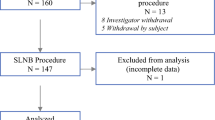Abstract
Background
Some hospitals lack facilities for radioisotopes in sentinel node biopsy. A novel method is used with a superparamagnetic tracer and a magnetometer instead of a radioisotope.
Methods
Thirty patients were included in the study after obtaining IRB approval. Superparamagnetic iron oxide and patent blue dye were injected in the subareolar breast tissue. Following a few minutes of massage to promote migration of the iron tracer and blue dye throughout the lymphatic vessels, the axillary lymph nodes were detected transdermally using a handheld magnetometer and followed by standard axillary dissection in all patients.
Results
Of 30 patients evaluated, sentinel lymph nodes were identified in 90% (27/30) using both blue dye and magnetic tracer. Sentinel lymph nodes were identified using the magnetic method in 23/30 (77%) and blue dye in 24/30 (80%). There was one false-negative sentinel node, resulting in an overall sensitivity of 6/7 (86%).
Conclusions
This is the first study to use a magnetic tracer to identify sentinel lymph nodes in patients with breast cancer. This new technique may alter the role of radioisotopes with further refinement and experience.



Similar content being viewed by others
References
Krag DN, Weaver DL, Alex JC, Fairbank JT. Surgical resection and radiolocalization of the sentinel lymph node in breast cancer using a gamma probe. Surg Oncol. 1993;2:335–9.
Giuliano AE, Kirgan DM, Guenther JM, Morton DL. Lymphatic mapping and sentinel lymphadenectomy for breast cancer. Ann Surg. 1994;220:391–8.
Cody HS. Sentinel lymph node mapping in breast cancer. Breast Cancer. 1999;6:13–22.
Albertini JJ, Lyman GH, Cox C, Yeatman T, Balducci L, Ku N, et al. Lymphatic mapping and sentinel node biopsy in the patient with breast cancer. JAMA. 1996;276:1818–22.
Derossis AM, Fey J, Yeung H, Yeh SD, Heerdt AS, Petrek J, et al. A trend analysis of the relative value of blue dye and isotope localization in 2,000 consecutive cases of sentinel node biopsy for breast cancer. J Am Coll Surg. 2001;193:473–8.
Radovanovic Z, Golubovic A, Plzak A, Stojiljkovic B, Radovanovic D. Blue dye versus combined blue dye-radioactive tracer technique in detection of sentinel lymph node in breast cancer. Eur J Surg Oncol. 2004;30:913–7.
Motomura K, Inaji H, Komoike Y, Hasegawa Y, Kasugai T, Noguchi S, et al. Combination technique is superior to dye alone in identification of the sentinel node in breast cancer patients. J Surg Oncol. 2001;76:95–9.
Krag DN, Anderson SJ, Julian TB, Brown AM, Harlow SP, Ashikaga T, et al. Technical outcomes of sentinel-lymph-node resection and conventional axillary-lymph-node dissection in patients with clinically node-negative breast cancer: results from the NSABP B-32 randomized phase III trial. Lancet Oncol. 2007;8:881–8.
Dale PS, Williams JT IV. Axillary staging utilizing selective sentinel lymphadenectomy for patients with invasive breast carcinoma. Am Surg. 1998;64:28–31.
Guenther JM, Krishnamoorthy M, Tan LR. Sentinel lymphadenectomy for breast cancer in a community managed care setting. Cancer J Sci Am. 1997;3:336–40.
Grube BJ, Giuliano AE. Observation of the breast cancer patient with a tumor-positive sentinel node: implications of the ACOSOG Z0011 trial. Semin Surg Oncol. 2001;20:230–7.
Miner TJ, Shriver CD, Flicek PR, Miner FC, Jaques DP, Maniscalco-Theberge ME, et al. Guidelines for the safe use of radioactive materials during localization and resection of the sentinel lymph node. Ann Surg Oncol. 1999;6:75–82.
Omoto K, Hozumi Y, Omoto Y, Taniguchi N, Itoh K, Fujii Y, et al. Sentinel node detection in breast cancer using contrast-enhanced sonography with 25% albumin—initial clinical experience. J Clin Ultrasound. 2006;34:317–26.
Kitai T, Inomoto T, Miwa M, Shikayama T. Fluorescence navigation with indocyanine green for detecting sentinel lymph nodes in breast cancer. Breast Cancer. 2005;12:211–5.
Weissleder R, Elizondo G, Wittenberg J, Lee AS, Josephson L, Brady TJ. Ultrasmall superparamagnetic iron oxide: an intravenous contrast agent for assessing lymph nodes with MR imaging. Radiology. 1990;175:494–8.
Weissleder R, Elizondo G, Wittenberg J, Rabito CA, Bengele HH, Josephson L. Ultrasmall superparamagnetic iron oxide: characterization of a new class of contrast agents for MR imaging. Radiology. 1990;175:489–93.
Michel SC, Keller TM, Frohlich JM, Fink D, Caduff R, Seifert B, et al. Preoperative breast cancer staging: MR imaging of the axilla with ultrasmall superparamagnetic iron oxide enhancement. Radiology. 2002;225:527–36.
Ferrucci JT, Stark DD. Iron oxide-enhanced MR imaging of the liver and spleen: review of the first 5 years. AJR Am J Roentgenol. 1990;155:943–50.
Nakagawa T, Minamiya Y, Katayose Y, Saito H, Taguchi K, Imano H, et al. A novel method for sentinel lymph node mapping using magnetite in patients with non-small cell lung cancer. J Thorac Cardiovasc Surg. 2003;126:563–7.
Minamiya Y, Ito M, Katayose Y, Saito H, Imai K, Sato Y, et al. Intraoperative sentinel lymph node mapping using a new sterilizable magnetometer in patients with nonsmall cell lung cancer. Ann Thorac Surg. 2006;81:327–30.
Ishiyama K, Sashi R, Katayose Y, Tomura N, Watarai J, Narita K. Sentinel lymph node after intramammary injection of superparamagnetic iron oxide (article in Japanese). Nippon Igaku Hoshasen Gakkai Zasshi. 2002;62:744–6.
Acknowledgments
This work is partially supported by Jichi Medical University Young Investigator Award. The authors gratefully thank Jyun Hirota and Shinsaku Maeda for technical assistance with the magnetometer.
Author information
Authors and Affiliations
Corresponding author
About this article
Cite this article
Shiozawa, M., Lefor, A.T., Hozumi, Y. et al. Sentinel lymph node biopsy in patients with breast cancer using superparamagnetic iron oxide and a magnetometer. Breast Cancer 20, 223–229 (2013). https://doi.org/10.1007/s12282-011-0327-9
Received:
Accepted:
Published:
Issue Date:
DOI: https://doi.org/10.1007/s12282-011-0327-9




